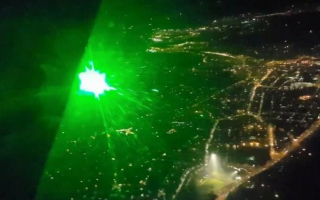Laser pointer safety regulation status
Would you like to manage an Appendix feeded by Sylodium as LaserTrade: platform of Laser Business from Asia and EU to Africa
contact us here: mayado@sylodium.com
This new is from LaserFocusWorld.com
Last October, the U.S. Food and Drug Administration (FDA) proposed banning laser pointers that are not red or red-orange by designating green, blue, and other colors as "defective" (see photo). The primary goal is to help restrict green and blue pointers. These currently account for 95% of the 7000+ reported incidents per year in the U.S. where a laser beam is aimed towards an aircraft.

Pilot illumination is a serious safety concern because bright light can disrupt pilot tasks, can cause veiling glare while the light is on, and can even temporarily flashblind a pilot. This visual interference is potentially hazardous during critical phases of flight: landing and takeoff, low-level flight and hover (helicopters), and emergencies.
Since 2004, there have been over 55,000 reported laser/aircraft illuminations in the U.S., UK, Canada, Australia, and Italy. Fortunately, none of these have resulted in any accidents, nor in any documented pilot eye injuries. But aviation officials, regulators, and lawmakers are concerned that laser light, in a critical situation at the wrong time, could be "the straw that broke the camel’s back." For example, Senator Charles Schumer (NY) has called three times for the FDA to take action against laser pointers.
On October 25, 2016, the FDA first presented its proposal to a public/industry/science advisory panel, the Technical Electronic Product Radiation Safety Standards Committee (TEPRSSC). The proposal is predicated primarily on the scotopic (dark-adapted) response of the human eye to various light wavelengths. The FDA told the committee that "colors at 615 nm and longer, viewed with night-adapted vision, appear only 1.4% as bright as green at the commonly manufactured 532 [nm]." According to the agency, "[t]he hazard from laser aircraft illuminations would be effectively eliminated if green and blue laser pointers were not available."
The FDA told TEPRSSC that it is considering designating all laser pointers from 400 nm (deep violet/near-UV) through blue, green, and yellow to 609 nm (red-orange) as "defective" under 21 CFR 1003.2. This is because such pointers "emit electronic product radiation unnecessary to the accomplishment of its primary purpose, which creates a risk of injury."
This would not make possession of current laser pointers illegal at the federal level. It would allow the federal government to ban the manufacture, importation, or sale of new non-red laser pointers. If some professions required specialized pointers, a manufacturer could request a FDA variance, allowing sales to law enforcement or other authorized users. However, the FDA is not set up to allow variances for individual sales. So, a person who wanted to buy a non-red laser pointer would not be able to obtain a newly manufactured laser pointer.
A key advantage of this rule is that pointers could be controlled by color. A customs official does not need to measure a laser pointer's power—he or she could reject a shipment if there were any non-red beams emitted. States and cities could pass similar color-based restrictions based on the FDA's action so that local authorities could confiscate laser pointers based on their colors.
The TEPRSSC submission is a first stage in rule-making. Based on TEPRSSC's response—and most members who commented were in favor—the FDA would then decide on a final proposal to be printed in the Federal Register. There would be a period for public comment. Depending on the comments, the FDA could 1) retain or slightly modify its proposal and make it into a new rule, 2) could modify it substantially and re-submit as a new proposal, or 3) could drop the proposal and make no changes to laser pointer regulations.
As of May 2017, there has been no word from the FDA as to whether this proposal will go to the Federal Register stage. Further blurring the outlook is President Trump's January 30, 2017 Executive Order seeking to reduce the number of federal regulations.
The actual TEPRSSC proposals and hearing transcripts are available online—see the "For More Details" section of www.fdatep.com/oct-2016-meeting.html.
Patrick Murphy is the editor of LaserPointerSafety.com; e-mail: mail@laserpointersafety.com; www.laserpointersafety.com.

